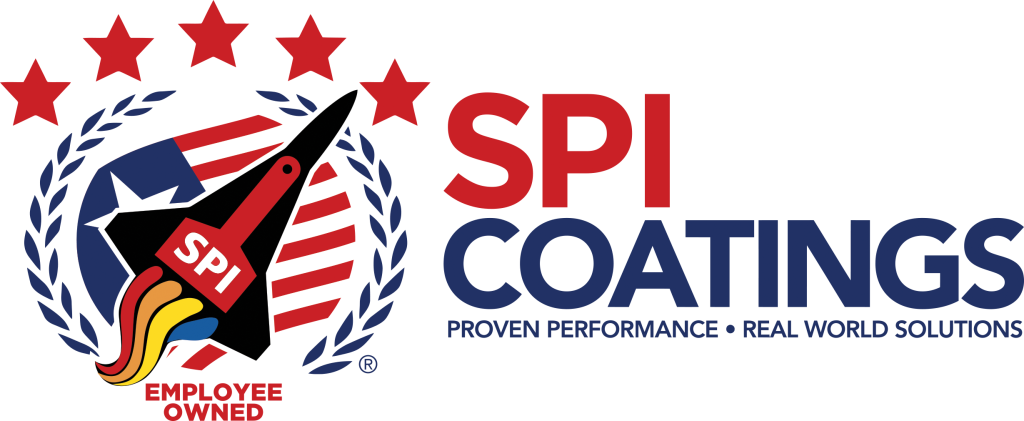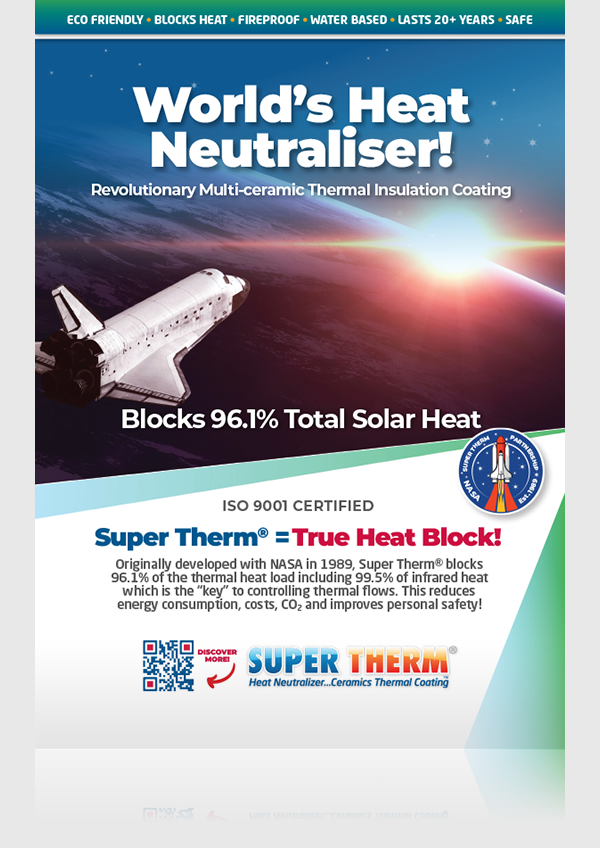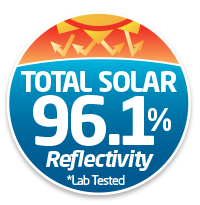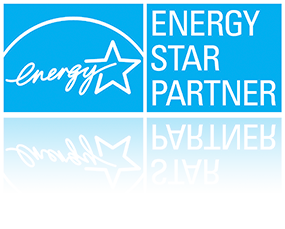Busting the myth on solar thermal reflective paints, and having a cool roof
For longer than 30 years, we understand at NEOtech Coatings that many people struggle to comprehend or even believe an insulation coating can work to the high standards of Super Therm® that blocks 96.1% of heat. Many people have experienced average performance with heat reflective paints that don’t match up to their exceptions and now the true solar heat block coating is here.
Super Therm® stands alone in its test results, longevity and performance. Unlike heat reflective paints that do part of the job for a little bit of the time, Super Therm® is proven to deliver future proof solar heat protection around the world and in Australia. While traditional insulation is important, its vital new ways are adopted to tackle our future, hot landscape which traditional methods of insulation can no longer manage in Australia.
Source: Efficiency Matrix: Airtightness specialists for a high performance building envelope (dated 5 January, 2022)
Here at Efficiency Matrix we are not rocket scientists but some of the claims/assumptions out on the internet, really needs to be straightened out, and explained in a manner where, most people will be able to understand.
Fortunately Superior Products International II, Inc did work with NASA on the development of Super Therm® Solar Heat Block Coating for over 6 years with J.E. Pritchett (Inventor and President of SPI Coatings) invited to speak at the NASA conference in Chicago in 1995 as a ceramics expert…there’s a few rocket scientists in NASA.
Lets start firstly with an explanation of what the building envelope actually is: It includes the external walls, ceiling, and floor that connects you to the outside environment.
…and the roof! Envelope is a covering or containing structure or layer.
Considering that reflective paint works by deflecting radiant visual energy, we decided to model radiant energy transfer comparisons using different building envelope products.
Very true; reflecting paint works on visual energy; fortunately Super Therm® Ceramic Solar Heat Block Coating has been designed, proven and globally tested to block 92% visual light heat, 99% UV heat and 99.5% infrared heat.
Before we go in to the modelling of what white paint/solar thermal reflective paints can do, let’s talk about the different spectrums of energy that comes from the sun and the spectrum of energy that comes from building materials and materials that the earth is made of.

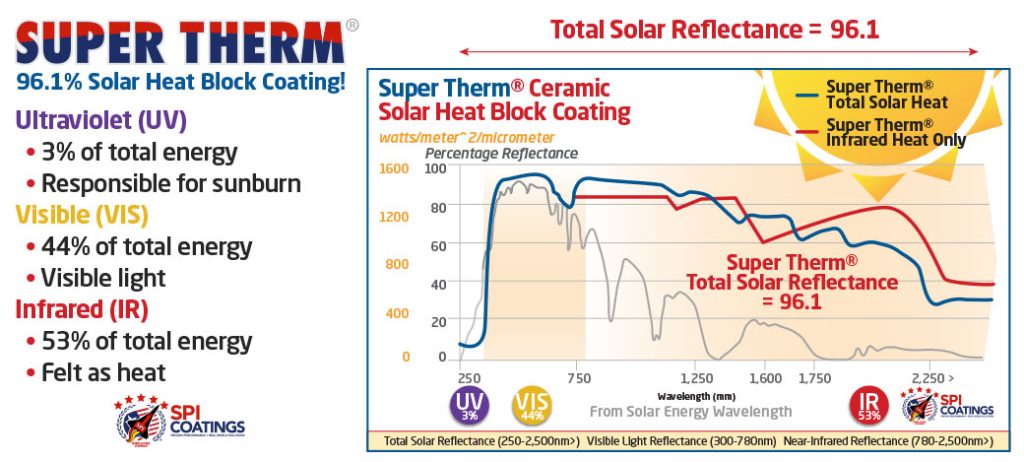
When considering different building envelope products, it’s important to understand that energy radiates from all objects, the sun radiates energy primarily on the visual spectrum and near infrared, and Indoor objects in a house here on earth radiate on the middle to far infrared spectrum.
As a silver bullet argument, A paint/coating, 1 mm in thickness does not provide any meaningful insulation. As an example to justify this claim, the best insulation in the world (aerogel, k=0.02, so R=t/k=0.001/0.02=R 0.05 m².K/W) has an R-value of .05, where most homes in Australia require ceiling insulation of R 4.1.
Super Therm is applied to 425 microns wet and dries to 250 microns. Insulation coatings and heat reflective paints cannot make any R values claims. However the Total Solar Reflectance above shows Super Therm’s testing results. Super Therm® isn’t bulk insulation like fibreglass, it’s a coating that blocks 96.1% of the solar heat load on the outside of the envelope; either roof or walls.
High solar reflectance (white paint) reduces direct sun energy absorption (albedo), hence a cool roof energy saving claim is supported. In the above chart look at how much energy makes the earths surface in the visual spectrum range. Its huge! But it only benefits energy efficiency for a few hours of the day. The sun is only actively forcing its energy on our buildings during 3-4 peak hours of the day and yet we expect comfort 24 hours of the day.
True, Super Therm® is designed and tested to prevent infrared heat load which is 53% of the heat and works while dirty, therefore working as soon as the sun hits it…this if highly valuable and reduces heat load, air conditioning consumption and lower temperatures inside any building or structure it covers.
Earth receives energy from the sun in the form of solar radiation—radiation with varying wavelengths along the electromagnetic spectrum. The sun emits strongly in the visible light range, but it also produces ultraviolet and near infrared radiation. This spectrum is highly dependent on the effect of the atmosphere. The earth radiates heat back to space mostly at much longer wavelengths (Middle to far Infrared at a much lower intensity).
Moving onto the myths that are doing the rounds, regarding high reflective/white paint benefits. At the bottom of this article we modelled different solutions for keeping heat out of a building and keeping heat inside of the building, using different building envelope materials.
Myth #1
Solar reflective paint can be applied to the inside of a building to keep it warm.
White Paint and solar reflective paint needs to be sunlit in order to work. Take away the sun light, it then provides no building performance benefit.
True, mostly. Super Therm® does contain conductive properties, however it is designed primarily to block external solar heat load. Because Super Therm® is fire rated Class ‘A’ by NASA it won’t burn under normal circumstances there’s been an example of interior walls left standing after a fire inside a house that did use Super Therm®. Oh and it also has been proven to reduce sound acoustics by 50-68%. Super Therm® is also a moisture barrier and reduces thermal shock therefore extending the life of steel roofs. As it has a very strong urethane and acrylic binding agent it bonds strongly to the substrate where moisture cannot get behind the coating unlike acrylic paints.
Dulux went down this path, and they paid a heavy price.
Super Therm® test results speak for themselves
Sarking has a way better performance than what any paint could do, due to its high reflective capabilities with medium to far Infrared spectrum energy which all homes radiate internally.
True for internal use
It is indeed a myth. To put this into perspective, sarking (reflective foil) does NOT perform nearly as well as bulk insulation in keeping energy inside a building envelope, so how could a visually coloured thin layer of paint compare to sarking? Introducing a thin layer of paint will NOT insulate or radiate temperature/energy back into the building envelope. The only example of where painting the inside of your house with a thermal reflective paint might be of any use, is if you plan on launching rockets into earths orbit from inside your living room. Which is what NASA originally used the thermal reflective paint for.
That’s funny about NASA. Fortunately Super Therm® was developed with NASA. We also don’t suggest paints work as the article has described either, however SPI Coatings do have other coatings like HSC® and HPC® that are design as conductive insulation coatings and fire management that do insulate yet need to be applied thick…much thicker than a traditional paint. Check them out!
It could explain why they demonstrated the use of a blow torch in this video to test how “insulative” their product is on TV. In other videos online, testing of these paint products with infrared heat lamps can be found, but unfortunately such high intensity near infrared heat does not radiate from everywhere inside the building envelope other than the actual heater itself.
J.E. demonstrates emissivity with Super Therm®
Myth #2
The other related Myth, which is also spoken about,
Painting your roof with a solar reflective paint can assist the performance of a building in winter and cold nights
Solar reflective paint does not keep your house warmer in winter because it is solar VISIBLE reflective, not infrared reflective. Thus a house warmed by its heating system in winter loses some heat through the roof by infrared radiation to the night sky and it is not blocked by solar reflective paint.
True for heat reflective paint. Super Therm is a ceramic solar heat block coating and is designed for warm to hot environments. Super Therm works great with other bulk insulation materials to reduce heat load going internal…other traditional and bulk insulation works well to slow heat loss. In Queensland, Northern Territory and Northern Western Australia heat loss isn’t an issue like Tasmania or cooler environments. We know that when the temperature’s over 35°C Super Therm will stop the heat load while roofs will reach 60°C+…insulation can’t stop that. Interestingly bulk insulation has only been tested in a lab at 23°C to establish it’s R rating…somehow that’s never mentioned in the results and conversation.
Myth #3
Urban Heat Island effect is not considered in the modelling simulations, which is critical for showing cool roof benefits, when mechanical plants are air cooled and roof mounted.
Heat island effect is only significant when there is no wind (i.e. local high energy density in cities), but almost always (in Melbourne specifically), at peak loads there are hot northerly winds, and this disrupts the heat island effect, thus heat island effect on rooftop equipment performance is nullified. Other cities may be less windy and Urban Heat Island may come into play, but not likely.
Well that isn’t quite right. Urban Heat Island effect is seriously contributed by roof temperatures. In fact Tanya Roe, Senior Consultant, Sustainability, City of Adelaide states ‘roofs typically account for 20-25% and pavements 40% of city surfaces, each absorbing 80% of sunlight reaching them and converting it into heat‘. Heat is trapped in bulk insulation and released at night. This in itself isn’t a main cause, however thousands of air conditioners running in a city at night trying to keep cool from that trapped insulation heat is a major cause of the UHI.
This is so important that countries and cities around the world are looking to Cool Roof Strategies to reduce the UHI impact. Parramatta is terrified of summers due to UHI and other heat related issues while Darwin’s homes are a majority white roofs. Super Therm® prevents the heat load, therefore keeping the building cooler, therefore reducing the need for extreme air conditioning uses and costs, therefore reducing the impact of UHI, therefore protecting our environment and reducing global warming. No bulk insulation can ever make that claim as they contribute to the UHI challenge through their conductive properties.
| v | ||
| City of Parramatta (Google Maps) | City of Darwin (Google Maps) |
Sarking Effectiveness is no Myth
Sarking can reflect and keep a home warm, but can also keep a building cool in warm climates.
It most definitely helps, but…
Dust and mould buildup on its surface over time can degrade its performance. Foil needs to remain shiny and clean for it to perform optimally. This happens naturally with vertical foil in walls and foil facing down which remain dust free for 50+ years, hence providing reliable reflective insulation. But foil facing up does degrade from dust deposition and the Australian Standard 4859 states a deration in its performance in this circumstance.
There are some products coming to the market now where there are layers of foil with an appropriate gap in between. These types of products can produce some great results.
Awesome thing about Super Therm® is it’s tested to be mould and mildew resistant unlike bulk insulation. As stated foil needs to remain shiny and clean like heat reflective white paints…Super Therm works even when dirty. Love to see the testing results around sarking ‘also keep a building cool in warm climates‘ particularly on a 40°C day as we know Super Therm as been tested at 23°, 50°, 75° and 100°C with the same great results.
The internal cavities of walls/ceilings and subfloor
The internal cavities of the building envelope whether they be walls, subfloor or the roof area can be problem areas for condensation which leads to unhealthy mould and material damage. it’s important their insulation and vapour barriers are designed to avoid condensation.
Another great thing is Super Therm® reduces condensation because it stablises the substrate from large temperature variations. That’s a problem with bulk insulation, moisture. Edoardo Verduci’s article on insulation properties states “as the temperature increase or humidity level increase, the R-value of a product decreases, meaning it’s less effective at slowing down the transfer of heat. Real world situations can compromise the R-value of traditional insulation substantially (imagine that traditional insulation can lose 35% of its R-value when as little as 1.5% humidity is introduced).” (Verduci, 2019). Maybe out of sight is out of mind.
There are many potential solutions for stopping heat transfer from extremely hot days and cold days, and it is best to seek an expert for the optimum cost-effective solution to your building. For example, solar reflective paints have great benefit in hot sunny locations and if the roof has poor insulation, but is less cost-effective if the roof is already well insulated. Often the most cost effective retrofit is sealing a roof with spray foam insulation, as this can also reduce thermal bridging at frames which are thermal leaks.
Potential solutions aren’t solutions. Super Therm® is a proven solution for hot days and works with bulk insulation on cold days as a team. It’s not a case of us versus them, it’s a team working together for the maximum benefit to thermal barrier protection. Bulk insulation can’t manage extreme heat. In fact, it loads heat and releases it at night. Reducing heat load is important in summer ‘assuming an electricity usage rate of 35c/kWh you can expect to outlay between $3/hour to keep cool in summer, and $1.85/hour to stay warm in winter (39% more to run energy in summer than winter). This will vary based on the energy efficiency of your system and number of rooms you want cooled/heated (Gibson, 2020). Even YourHome Australian Government website state ‘If the roof is being painted to restore colour, select the lightest colour permissible (heat-reflective roof paints are also an option) and then match the remaining colour scheme to it.‘

As you’d expect, bulk insulation is slowing the heat transfer out of the building. Perfect reason to have bulk insulation and as you see below ‘solar reflective coating’ to reduce summer heat gain. The graphs say it all…well mostly.

While the graph above shows heat gain from the ceiling bulk insulation has proven its a conduction heat insulation material and done the job as it should. The coating still has performed well although its not designed for conductive heat. 2 interesting things. Firstly colour does matter as the black roof sucks heat in…great for Britain perhaps but not Australia and again there’s a ton of missing data. Misses showing ambient temperature external, humidity, date or time of the day this was sampled. Great to see the independent testing results and materials used.
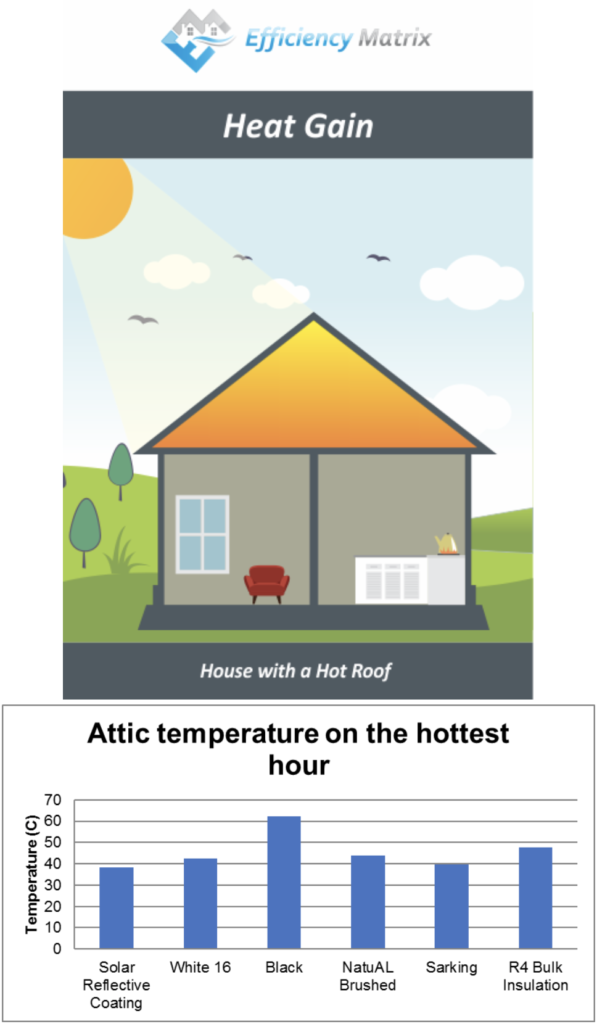
The graph above doesn’t show ambient temperature external, humidity, date or time of the day this was sampled along with what type of ‘solar reflective coating’. So much missing information. Regardless it still shows the temperature of the coating outperformed the rest to reducing heat into the roof space.
Real solutions for improving the performance of a roof.
If a building does NOT have insulation, using solar reflective paints CAN improve comfort within a building during summer hot climates during sunny time but not cold winter climates. If there is no insulation in your building, consider spray foam insulation as well.
If there is insulation, consider the below retrofits.
- Repairing sarking/foil that is torn and ripped under a tin roof, with foil tape.
- Fix up gaps in your insulation.
- Use an expanding foam around the whole perimeter of a tin roof to improve the air tightness of the roof, reducing stack effect, and the general air tightness of a building. This solution would generally be undertaken above a false sealing system. Insulation consistency and air tightness is where real savings can be realised.
Understand that real energy efficiency performance is realised by improving air tightness and ensuring that insulation consistency is located on that air tightness layer. A cool roof does not improve energy efficiency if your ceiling is consistently insulated and air tight. And even if the ceiling isn’t consistently insulated, the roof area temperature is not lowered enough using a paint to make a quantifiable difference.
Yeah, not really…testing worldwide has proven cool roofs do improve energy efficiency. Roof colours matter enormously but in today’s environment and looking forward everything should be done together to manage better thermal barriers for the whole building. Times have changed and coatings are the new era to block heat on the front line to reduced heat load into buildings.
While we get the impression this article is written for Melbourne’s environment, the City of Melbourne have published ‘Melbourne is experiencing hotter days. We currently average 11 days greater than 35 degrees. By 2050 we will experience an average 16 days greater than 35 degrees. Even though Melbourne and Adelaide are located in more temperate areas (in comparison with more northerly cities such as Brisbane), they have been periodically hit by severe heatwaves. A study also found that “heatwave amplitude” – the intensity of the hottest day of the hottest heatwave – will increase more in southern parts of Australia.
In this article the solar reflective coating performed marginally better in summer and bulk insulation performed better in winter. That’s expected. It costs more to run air conditioners by 39% more in summer than heating in winter and as global temperatures continue rising and increased UHI effects air conditioning demands will increase therefore increasing CO2 emissions. Perhaps forward thinking is needed for the whole planet by everyone for a combination of the best options that work together. Super Therm® Ceramic Heat Block Coating is leading the way globally for undeniable, proven and tested heat block coatings that future proof for tough heat protection.






















